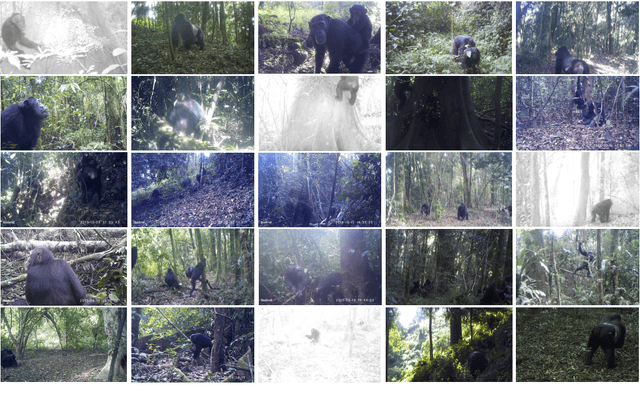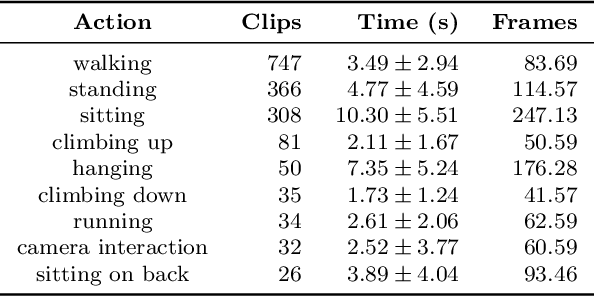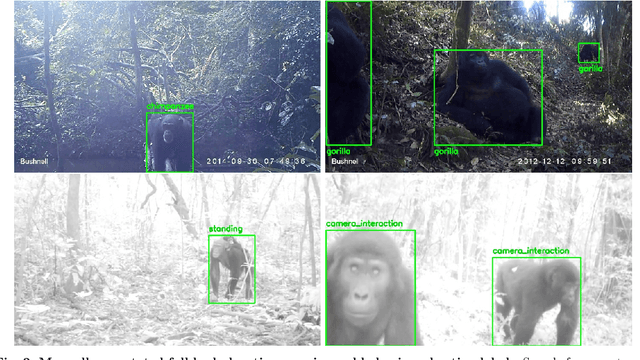Otto Brookes
The PanAf-FGBG Dataset: Understanding the Impact of Backgrounds in Wildlife Behaviour Recognition
Feb 28, 2025Abstract:Computer vision analysis of camera trap video footage is essential for wildlife conservation, as captured behaviours offer some of the earliest indicators of changes in population health. Recently, several high-impact animal behaviour datasets and methods have been introduced to encourage their use; however, the role of behaviour-correlated background information and its significant effect on out-of-distribution generalisation remain unexplored. In response, we present the PanAf-FGBG dataset, featuring 20 hours of wild chimpanzee behaviours, recorded at over 350 individual camera locations. Uniquely, it pairs every video with a chimpanzee (referred to as a foreground video) with a corresponding background video (with no chimpanzee) from the same camera location. We present two views of the dataset: one with overlapping camera locations and one with disjoint locations. This setup enables, for the first time, direct evaluation of in-distribution and out-of-distribution conditions, and for the impact of backgrounds on behaviour recognition models to be quantified. All clips come with rich behavioural annotations and metadata including unique camera IDs and detailed textual scene descriptions. Additionally, we establish several baselines and present a highly effective latent-space normalisation technique that boosts out-of-distribution performance by +5.42% mAP for convolutional and +3.75% mAP for transformer-based models. Finally, we provide an in-depth analysis on the role of backgrounds in out-of-distribution behaviour recognition, including the so far unexplored impact of background durations (i.e., the count of background frames within foreground videos).
Integrating Biological Data into Autonomous Remote Sensing Systems for In Situ Imageomics: A Case Study for Kenyan Animal Behavior Sensing with Unmanned Aerial Vehicles (UAVs)
Jul 23, 2024Abstract:In situ imageomics leverages machine learning techniques to infer biological traits from images collected in the field, or in situ, to study individuals organisms, groups of wildlife, and whole ecosystems. Such datasets provide real-time social and environmental context to inferred biological traits, which can enable new, data-driven conservation and ecosystem management. The development of machine learning techniques to extract biological traits from images are impeded by the volume and quality data required to train these models. Autonomous, unmanned aerial vehicles (UAVs), are well suited to collect in situ imageomics data as they can traverse remote terrain quickly to collect large volumes of data with greater consistency and reliability compared to manually piloted UAV missions. However, little guidance exists on optimizing autonomous UAV missions for the purposes of remote sensing for conservation and biodiversity monitoring. The UAV video dataset curated by KABR: In-Situ Dataset for Kenyan Animal Behavior Recognition from Drone Videos required three weeks to collect, a time-consuming and expensive endeavor. Our analysis of KABR revealed that a third of the videos gathered were unusable for the purposes of inferring wildlife behavior. We analyzed the flight telemetry data from portions of UAV videos that were usable for inferring wildlife behavior, and demonstrate how these insights can be integrated into an autonomous remote sensing system to track wildlife in real time. Our autonomous remote sensing system optimizes the UAV's actions to increase the yield of usable data, and matches the flight path of an expert pilot with an 87% accuracy rate, representing an 18.2% improvement in accuracy over previously proposed methods.
ChimpVLM: Ethogram-Enhanced Chimpanzee Behaviour Recognition
Apr 13, 2024Abstract:We show that chimpanzee behaviour understanding from camera traps can be enhanced by providing visual architectures with access to an embedding of text descriptions that detail species behaviours. In particular, we present a vision-language model which employs multi-modal decoding of visual features extracted directly from camera trap videos to process query tokens representing behaviours and output class predictions. Query tokens are initialised using a standardised ethogram of chimpanzee behaviour, rather than using random or name-based initialisations. In addition, the effect of initialising query tokens using a masked language model fine-tuned on a text corpus of known behavioural patterns is explored. We evaluate our system on the PanAf500 and PanAf20K datasets and demonstrate the performance benefits of our multi-modal decoding approach and query initialisation strategy on multi-class and multi-label recognition tasks, respectively. Results and ablations corroborate performance improvements. We achieve state-of-the-art performance over vision and vision-language models in top-1 accuracy (+6.34%) on PanAf500 and overall (+1.1%) and tail-class (+2.26%) mean average precision on PanAf20K. We share complete source code and network weights for full reproducibility of results and easy utilisation.
PanAf20K: A Large Video Dataset for Wild Ape Detection and Behaviour Recognition
Jan 31, 2024



Abstract:We present the PanAf20K dataset, the largest and most diverse open-access annotated video dataset of great apes in their natural environment. It comprises more than 7 million frames across ~20,000 camera trap videos of chimpanzees and gorillas collected at 14 field sites in tropical Africa as part of the Pan African Programme: The Cultured Chimpanzee. The footage is accompanied by a rich set of annotations and benchmarks making it suitable for training and testing a variety of challenging and ecologically important computer vision tasks including ape detection and behaviour recognition. Furthering AI analysis of camera trap information is critical given the International Union for Conservation of Nature now lists all species in the great ape family as either Endangered or Critically Endangered. We hope the dataset can form a solid basis for engagement of the AI community to improve performance, efficiency, and result interpretation in order to support assessments of great ape presence, abundance, distribution, and behaviour and thereby aid conservation efforts.
Triple-stream Deep Metric Learning of Great Ape Behavioural Actions
Jan 06, 2023



Abstract:We propose the first metric learning system for the recognition of great ape behavioural actions. Our proposed triple stream embedding architecture works on camera trap videos taken directly in the wild and demonstrates that the utilisation of an explicit DensePose-C chimpanzee body part segmentation stream effectively complements traditional RGB appearance and optical flow streams. We evaluate system variants with different feature fusion techniques and long-tail recognition approaches. Results and ablations show performance improvements of ~12% in top-1 accuracy over previous results achieved on the PanAf-500 dataset containing 180,000 manually annotated frames across nine behavioural actions. Furthermore, we provide a qualitative analysis of our findings and augment the metric learning system with long-tail recognition techniques showing that average per class accuracy -- critical in the domain -- can be improved by ~23% compared to the literature on that dataset. Finally, since our embedding spaces are constructed as metric, we provide first data-driven visualisations of the great ape behavioural action spaces revealing emerging geometry and topology. We hope that the work sparks further interest in this vital application area of computer vision for the benefit of endangered great apes.
A Dataset and Application for Facial Recognition of Individual Gorillas in Zoo Environments
Dec 08, 2020



Abstract:We put forward a video dataset with 5k+ facial bounding box annotations across a troop of 7 western lowland gorillas at Bristol Zoo Gardens. Training on this dataset, we implement and evaluate a standard deep learning pipeline on the task of facially recognising individual gorillas in a zoo environment. We show that a basic YOLOv3-powered application is able to perform identifications at 92% mAP when utilising single frames only. Tracking-by-detection-association and identity voting across short tracklets yields an improved robust performance of 97% mAP. To facilitate easy utilisation for enriching the research capabilities of zoo environments, we publish the code, video dataset, weights, and ground-truth annotations at data.bris.ac.uk.
 Add to Chrome
Add to Chrome Add to Firefox
Add to Firefox Add to Edge
Add to Edge